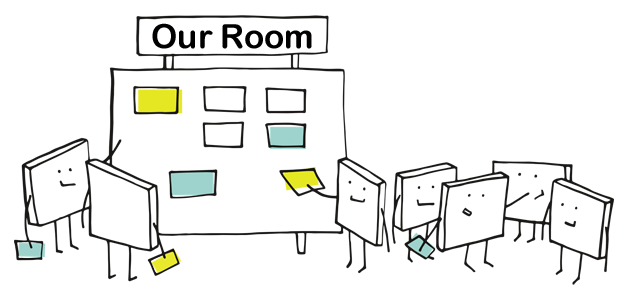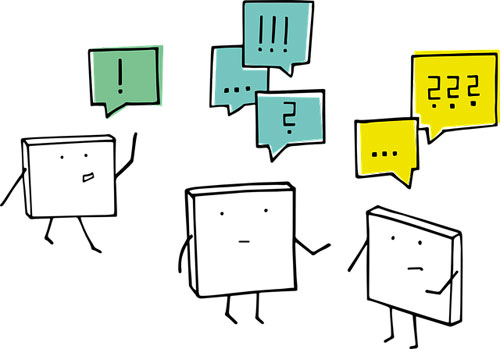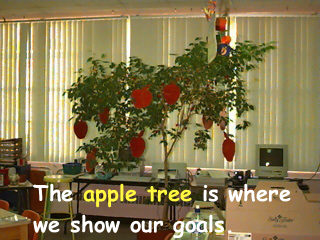
Students apply their knowledge of locations and rules to create a tour of the classroom.

At the beginning of each new school year, everything is new for students. They have a new teacher, a new classroom, and new routines to learn. But after a few weeks, students have learned how to navigate your classroom and many processes have become second nature.
It can be a little scary to come to a new class with new rules. Once your students have learned and settled into your classroom routine, ask them to apply their knowledge of locations and rules to design a classroom tour for new, or next year’s, students.
This lesson asks students to design a tour of your classroom that shows important features and how they are used. Use this lesson at the beginning of the year to help students cement their understanding of classroom spaces and rules. Use this lesson at the end of the year to practice and apply writing and oral fluency skills like prepositions, descriptive language and grammar rules.
Kick off the project with a discussion about how it feels to be in a new unfamiliar place. You might ask them to think back to the beginning of the school year when everything was new. What did it feel like to meet a new teacher, come into an unfamiliar classroom, and learn different routines?

Empower students to use what they know to help other students be more confident in a new learning environment by creating a tour that maps out important features of the classroom and states rules and procedures for that area.
Ask students to brainstorm and identify important features in your classroom, such as the door, reading corner, teacher's desk, pencil sharpener, and so on. Create a list of these important places where all students can see them.
Before you create a map of the classroom, review or introduce key positional prepositions like: above, below, beside, in front of, behind, and next to. Knowing these words will be essential in creating a map together so others can easily find these places in your classroom.
You can introduce these words to students by reading a fun book, like Rosie's Walk by Pat Hutchins, or with a musical approach like The Prepositions Song.
Create an anchor chart of positional words, or add them to a word wall, so students can easily see each word and how to spell it.
Work together to create a map of the classroom. Unit measurements and area are too advanced for young learners, so start by drawing the shape of your classroom on a large piece of butcher paper on the floor, on your white board, or even using a digital tool, like Wixie, and projecting for the entire class to see. Have students help add each of the important places you have identified to the map.
If you want to give students additional practice with maps or written directions, create a classroom treasure hunt. Cambridge University Press’s World of Better Learning blog has a simple, yet fun, one that is perfect for primary students.
Now that you have created a classroom map, students are ready to design the tour. Assign, or have each student choose, a location they will describe and explain.
Walk around the room with students and take pictures of each place you have identified for the tour. If students are using tablets, have them take pictures themselves.
Print the images on paper or cardstock, or add them to a page in a digital tool, like Wixie. Depending on the time of year and age/ability of your learners, you can have them start from a blank page or create a template.

Have each student type or record a simple sentence naming the place with a brief description of it location in the room and purpose. For example, "The pencil sharpener is next to the door."
Then, have them type or record a second sentence about the activity that is done in this location and/or the rules for this place. For example, "Ask the teacher before you go sharpen your pencil."
Young learners are familiar with pattern stories. Scaffold writing and speaking for your emerging speakers and writers by creating sentence starters to help them write about the location and rules. For example:
Aides or older students can help students complete their sentences and record their voices.
When each student is done, collect all of their work into one book (print) or file (digital). Work as a class to decide the order the locations will be shared in your tour.
You can follow a similar process to create handbooks for classroom procedures. Have students create mini-handbooks or posters to share the procedures for checking out a library book, paying for lunch, signing in to a computer, or arriving at school in the morning.
How you share student work will depend on the audience and time that you create the tour.
If you ask students to create the tour as school begins, not only will they remember locations and rules, you now have a built in resource to share with new students who arrive after the year has begun. If you can print more than one copy, you can also share it with families as they visit during back-to-school night.
If you have students create at the end of the school year, have them add narration to their page to practice and apply fluency skills. Then, save as a video to share with next year's class over the summer to help make them feel more confident when they come to school.
Student’s understanding of prepositions and location will become apparent as you work together to create a classroom map. If you want to evaluate student understanding in this area more deeply, consider have students craft classroom maps individually as you list locations and discuss important features of your room.
Each student’s sentences can be used to evaluate descriptive and informational writing as well as reading, or oral, fluency.
Cari Meister. Where is It?. ISBN: 1977131573
Pat Hutchins. Rosie’s Walk. ISBN: 0027458504
Scratch Garden - The Prepositions Song
Red Cat Reading - How to Make a Map
D2.Geo.1.K-2.
Construct maps, graphs, and other representations of familiar places.
D2.Geo.2.K-2.
Use maps, graphs, photographs, and other representations to describe places and the relationships and interactions that shape them.
D2.Civ.10.K-2.
Compare their own point of view with others’ perspectives.
D2.Civ.12.K-2.
Identify and explain how rules function in public (classroom and school) settings.
CCSS.MATH.CONTENT.K.G.A.1
Describe objects in the environment using names of shapes, and describe the relative positions of these objects using terms such as above, below, beside, in front of, behind, and next to.
CCSS.ELA-LITERACY.W.K.2
Use a combination of drawing, dictating, and writing to compose informative/explanatory texts in which they name what they are writing about and supply some information about the topic.
CCSS.ELA-LITERACY.W.K.6
With guidance and support from adults, explore a variety of digital tools to produce and publish writing, including in collaboration with peers.
CCSS.ELA-LITERACY.L.K.2
Demonstrate command of the conventions of standard English capitalization, punctuation, and spelling when writing.
CCSS.ELA-LITERACY.SL.K.4
Describe familiar people, places, things, and events and, with prompting and support, provide additional detail.
CCSS.ELA-LITERACY.SL.K.5
Add drawings or other visual displays to descriptions as desired to provide additional detail.
CCSS.ELA-LITERACY.SL.K.6
Speak audibly and express thoughts, feelings, and ideas clearly.
6. Creative Communicator
Students communicate clearly and express themselves creatively for a variety of purposes using the platforms, tools, styles, formats and digital media appropriate to their goals. Students:
a. choose the appropriate platforms and tools for meeting the desired objectives of their creation or communication.
b. create original works or responsibly repurpose or remix digital resources into new creations.
d. publish or present content that customizes the message and medium for their intended audiences.

Follow us on Instagram for daily inspiration

Create a thought web, cluster, flowchart, or other graphic organizer for a lesson
Five ideas for creative classroom centers
Creative, digital book reviews
Fun and powerful ideas with animated characters

Wixie
Share your ideas, imagination, and understanding through writing, art, voice, and video.

Rubric Maker
Create custom rubrics for your classroom.

Pics4Learning
A curated, copyright-friendly image library that is safe and free for education.

Wriddle
Write, record, and illustrate a sentence.

Get creative classroom ideas delivered straight to your inbox once a month.
Topics